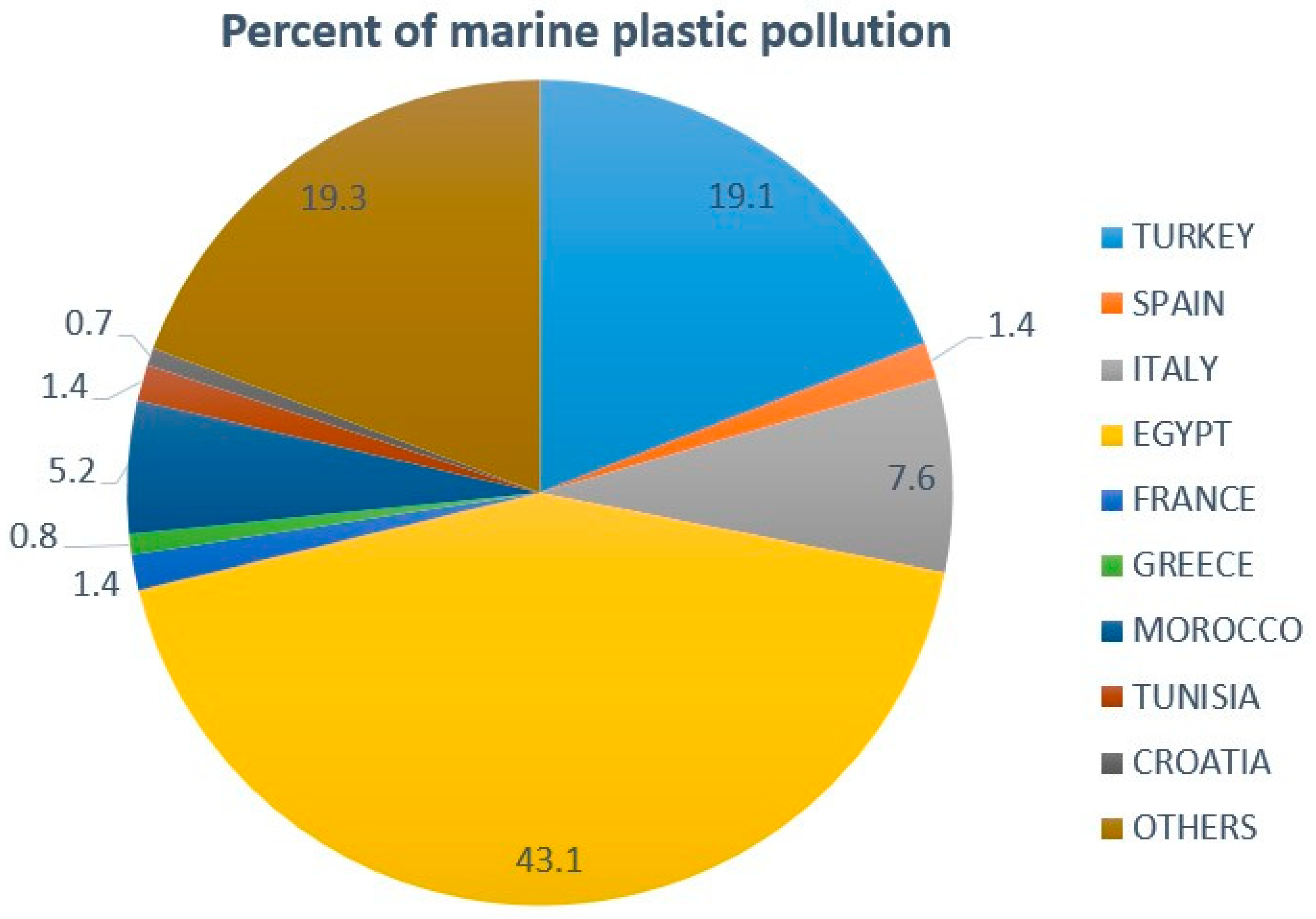Marine Pollution by Microplastics in the Mediterranean Sea
Abstract
:- Avoid producing plastic waste in natural environments.
- Develop national plans effective for the prevention, control and removal of plastic litter from marine environments.
- Ban plastic products from being a real risk for the presence of plastic waste.
- Prevent the discharge of plastics into rivers and freshwaters.
- Establish a scientific international committee specialized in plastic pollution.
Funding
Institutional Review Board Statement
Informed Consent Statement
Data Availability Statement
Acknowledgments
Conflicts of Interest
References
- MacLeod, M.; Arp, H.P.; Tekman, M.B.; Jahnke, A. The global threat from plastic pollution. Science 2021, 373, 61–65. [Google Scholar] [CrossRef] [PubMed]
- Eriksen, M.; Laurent, C.M.; Lebreton, H.; Carson, S.; Thiel, M.; Moore, C.J.; Borerro, J.C.; Galgani, F.; Peter, G.; Ryan, P.G.; et al. Plastic pollution in the World’s Oceans: More than 5 Trillion Plastic Pieces Weighing over 250.000 Tons Afloat at Sea. PLoS ONE 2014, 9, e111913. [Google Scholar] [CrossRef] [PubMed] [Green Version]
- Boucher, J.; Bilard, G. The Mediterranean: Mare Plasticum; IUCN: Gland, Switzerland, 2020; pp. 1–62. [Google Scholar]
- Suaria, G.; Avio, C.G.; Mineo, A.; Lattin, G.L.; Magaldi, M.G.; Belmonte, G.; Moore, C.J.; Regoli, F.; Aliani, S. The Mediterranean Plastic Soup: Synthetic polymers in Mediterranean surface waters. Sci. Rep. 2016, 6, 37551. [Google Scholar] [CrossRef] [PubMed] [Green Version]
- Sharma, S.; Sharma, V.; Chatterjee, J. Microplastics in the Mediterranean Sea: Sources, Pollution Intensity, Sea Health, and Regulatory Policies. Front. Mar. Sci. 2021, 8, 634934. [Google Scholar] [CrossRef]
- Uddin, S.; Fowler, S.W.; Behbehani, M. An assessment of microplastic inputs into the aquatic environment from wastewater streams. Mar. Pollut. Bull. 2020, 160, 111538. [Google Scholar] [CrossRef] [PubMed]
- Uddin, S.; Fowler, S.W.; Habibi, N.; Behbehani, M. Micro-nano plastics in the Aquatic Environment: Methodological Problems and Challenges. Animals 2022, 12, 297. [Google Scholar] [CrossRef] [PubMed]
- Dalberg Advisors. World Wide Fund for Nature, Report. Stop the Flood of Plastic: How Mediterranean Countries Can Save Their Sea; WWF Mediterranean Marine Iniziative: Rome, Italy, 2019; pp. 1–45. [Google Scholar]
- Liubartseva, S.; Coppini, G.; Lecci, R.; Clementi, E. Tracking plastics in the Mediterranean: 2d Lagrangian model. Mar. Pollut. Bull. 2018, 129, 151–162. [Google Scholar] [CrossRef] [PubMed]
- Lusher, A.L.; Tirelli, V.; O’Connor, I.; Officer, R. Microplastics in Artic polar waters: The first reported values of particles in surface and sub-surface samples. Sci. Rep. 2015, 5, 14947. [Google Scholar] [CrossRef] [PubMed] [Green Version]
- World Wild Fund. Mediterraneo in trappola. In Come Salvare il Mare Dalla Plastica; WWF Italy Report; WWF Rome: Rome, Italy, 2018; pp. 1–28. Available online: www.wwf.it/plastic (accessed on 20 March 2022).
- Avio, C.G.; Gorbi, S.; Regoli, F. Experimental development of a new protocol for extraction and characterization of microplastics in fish tissues: First observations in commercial species from Adriatic Sea. Mar. Environ. Res. 2015, 111, 18–26. [Google Scholar] [CrossRef] [PubMed]
- Habib, R.; Thiemann, T. Microplastic in Commercial Fish in the Mediterranean Sea, the Red Sea and the Arabian Gulf. Part 1: The Mediterranean Sea. Water Resour. Prot. 2021, 13, 563–587. [Google Scholar] [CrossRef]
- Tekman, M.B.; Bergman, M.; Lars, G. Litterbase: Online Portal for Marine Litter. Alfred Wegener Institute Helmoholtz. Centre for Polar and Marine Research. 2021. Available online: www.litterbase.org (accessed on 20 March 2022).
- UNEP/MAP. Marine Litter Assessment in the Mediterranean; UNEP/MAP: Athens, Greece, 2015; pp. 1–78. Available online: www.unep.org (accessed on 3 March 2022).

Publisher’s Note: MDPI stays neutral with regard to jurisdictional claims in published maps and institutional affiliations. |
© 2022 by the author. Licensee MDPI, Basel, Switzerland. This article is an open access article distributed under the terms and conditions of the Creative Commons Attribution (CC BY) license (https://creativecommons.org/licenses/by/4.0/).
Share and Cite
Cantasano, N. Marine Pollution by Microplastics in the Mediterranean Sea. J. Mar. Sci. Eng. 2022, 10, 858. https://doi.org/10.3390/jmse10070858
Cantasano N. Marine Pollution by Microplastics in the Mediterranean Sea. Journal of Marine Science and Engineering. 2022; 10(7):858. https://doi.org/10.3390/jmse10070858
Chicago/Turabian StyleCantasano, Nicola. 2022. "Marine Pollution by Microplastics in the Mediterranean Sea" Journal of Marine Science and Engineering 10, no. 7: 858. https://doi.org/10.3390/jmse10070858
APA StyleCantasano, N. (2022). Marine Pollution by Microplastics in the Mediterranean Sea. Journal of Marine Science and Engineering, 10(7), 858. https://doi.org/10.3390/jmse10070858





